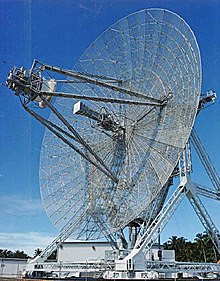Radar
Radar is a machine that uses radio waves for echolocation to find objects such as aircraft, ships, and rain.

The basic parts of a radar are:
- The transmitter creates the radio waves.
- The antenna directs the radio waves.
- The receiver measures the waves which are bounced back by the object.
By doing this, the radar can locate the object. Radar is used in many different ways. It can measure the speed and number of cars on a road, the amount of water in the air, and many other things.
The radar transmitter sends radio pulses. By controlling how often the rapid pulses of radar energy are sent out by a radar transmitter (called the transmitter's "pulse repetition rate"), and how long it takes for the reflected pulse energy to come back to the radar receiver, one can tell where objects are, and how far away. Digital circuits in a radar receiver calculate the distance to an object by knowing the time interval between energy pulses. The radar receiver's digital circuits count how long it takes between pulses for an object's reflected energy to be detected by the radar receiver. Since radar pulses are sent and received at approximately the speed of light, the distance to an object can easily be calculated. This is done in digital circuits by multiplying the speed of light by the time it takes to receive the radar energy reflected back from an object.
The time between pulses influences how far away an object can be detected. That distance is called the "range" of a radar transmitter and receiver. Radar transmitters and receivers use slow repetition frequencies to find the distance to objects that are far away. This makes it possible to accurately determine the distance to the moon, for example. Fast repetition is used to detect objects that are much closer, like ships at sea, high flying aircraft, or to determine the speed of fast moving automobiles on highways.
Radar was first used in 1904 by Christian Hülsmeyer. He was given a patent for radar (Reichspatent Nr. 165546). Radar was vital in the Battle of Britain and other parts of World War II. The Axis countries failed to keep up with British and American radar technology during the war.
The word RADAR was created in 1942 as an acronym for Radio Detection and Ranging.[1] This acronym replaced the British initialism RDF (Radio Direction Finding). The word is now thought of by many people as a regular word, no longer as an acronym.
The FAA (Federal Aviation Administration) use several kinds of radar:
- ARSR (Air Route Surveillance Radar)
- ASR (Airport Surveillance Radar)
- ASDE (Airport Surface Detection Equipment)
- TDWR (Terminal Doppler Weather Radar)
- PAR (Precision Approach Radar)
Related pages
changeReferences
change- ↑ "How Radar Works". Bureau of meteorology. Australian Government. Retrieved 28 May 2015.